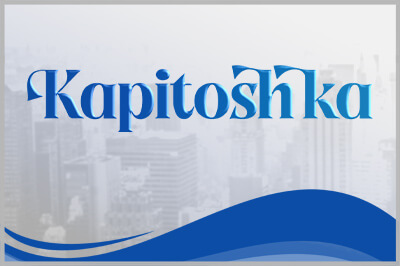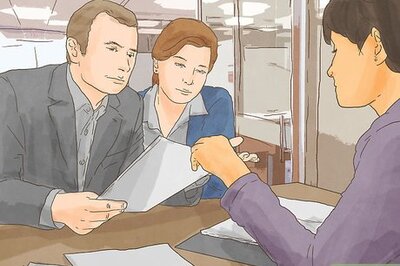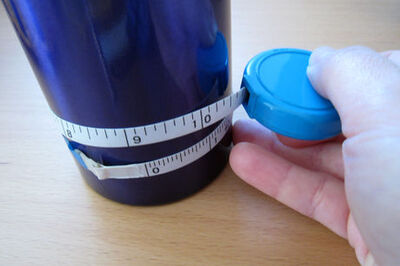
views
How to Do a Glute Ham Raise
Adjust the machine so your knees are just behind the pad. Glute ham developer (GHD) machines can typically be adjusted to accommodate people’s different leg lengths. Slide the foot plate backward or forward until you can kneel on the machine with the balls of your feet pressed firmly into the foot plate and your knees slightly behind the rounded pad in the middle of the machine. If the foot plate is too close to the machine, your knees will be toward the top of the pad, and the exercise will put too much tension on your knees. If the foot plate is too far away, you won’t be able to kneel on the machine.
Kneel on the machine with your torso straight up. Press your toes into the foot pad and your knees into the back of the rounded knee pad. Lift your torso so you create a straight line from your shoulders all the way down through your knees, with your spine neutral and your core engaged. Keep your feet straight up and down—don’t turn your toes out. Rotating your feet outward will take pressure off of your hamstrings, so the move won’t be as effective. Cross your arms over your chest, place your hands on your hips, or leave your arms straight down by your side.
Lower yourself by extending your knees until your torso is horizontal. Use a smooth, controlled motion and hold yourself steady with your glutes and hamstrings—don’t just fall forward. As you straighten your knees, they’ll move up and over the rounded knee pad. Keep your core tight, inhaling as you go down. If you’d like, you can hinge at the hips and continue past parallel at the bottom of the move—you’ll get a more complete hamstring extension, but it may be harder to lift yourself back up.
Squeeze your glutes and hamstrings to pull yourself up. Exhale and press your feet back into the foot plate and tighten your hams and glutes to lift your torso until you’re upright again. Don’t arch your back, and keep your core tight. When you finish, you should be back in the starting position. The biggest mistakes people make with a GHR is to lift with momentum or lead with their back on the way up. This puts too much strain on your lower back and raises your risk of injury. It also makes the workout less effective.
Do 3–4 sets of 5–8 reps. This is a challenging exercise, so it’s okay if you can’t do a complete set to start with—just do as many reps as you can while maintaining good form. As you build up strength, progress to being able to do 5–8 reps at a time. Rest for a few seconds, then repeat for a total of 3–4 sets. For most people, just working up to more reps should be challenging enough.
What if I can’t do a single GHR rep?
Use your hands to push yourself back up. Start the move as normal, lowering yourself with control down to a parallel position. Then, put your hands on the bars of the GHD machine and push yourself back up until your torso is vertical. Focus on going slowly on the eccentric part of the move (the part where you lower yourself). This will help you build strength in your glutes and hamstrings so you can eventually complete the move without your hands.
Have a partner help you. If you’re having trouble lowering yourself in a controlled way, ask a spotter to hold their arm in front of your chest. Lower yourself until your chest touches their arm, then lift yourself back up. As you get stronger, your partner can lower their arm, until you can eventually do the move on your own. Alternately, you can ask a spotter to push you up from the bottom of the move.
Use a resistance band to make the move easier. Loop a resistance band around the back of the machine and bring it up and over one shoulder. Hold the band in front of your chest with both hands and try the GHR again. The resistance band will help take some of the weight off of your hamstrings at the bottom of the move, which may make it easier. As you progress, move to a lighter band, and eventually no band at all.
How do I make the GHR harder?
Do more weights and reps. Glute ham raises are a tough exercise, so for most people, just doing more in a single workout will be difficult enough. Try to gradually increase your reps and sets until you can consistently do 4 sets of 12.
Slow down the exercise. Make the glute ham raise even more challenging by slowing it down. Try to count to 3 as you lowerself down, then count to 3 on your way back up. Once you can do that, increase the count to 4, then 5.
Add weights or bands. If you’ve mastered the GHR and you still want it to be harder, hug a weight to your chest or wear a weighted vest. Some lifters also use bands to add more resistance to the move.
Change the angle. You can make glute ham raises more difficult by moving the foot plate closer to the knee pad. If your GHD machine has a foot pad with an adjustable height, raising the foot pad can also make the move harder. If you can’t raise the foot pad on your GHD machine, you can prop the back of the machine up on something sturdy like a wooden board.
What do glute ham raises work?
Glute ham raises work your posterior chain. These are the muscles along the back of your body, including your glutes, hamstrings, lower back, and calves. They’re especially good at putting your hamstrings through a full range of motion, which can be difficult to accomplish with other moves. GHRs also work your core, since you have to stay braced through the entire move.
What are the benefits of the glute ham raise?
GHRs are good for balanced strengthening of your posterior chain. It can be hard to work your entire posterior chain at once—exercises that work your hamstrings may not work your quads, for instance. This can lead to muscular imbalances that can make you more prone to knee, hip, and back injuries. Glute ham raises can help correct these imbalances.
They’re a good way to work your hamstrings without stressing your back. Most exercises that work your hamstrings—like squats, good mornings, and deadlifts—are also really hard on your lower back. When you do a glute ham raise properly, you work your hamstrings without putting much strain on your back.
GHRs can help you run faster and lift heavier weights. Your posterior chain is important for all kinds of every day activities, like picking up heavy objects, getting up off the ground, and running. If you’re strength training, a stronger posterior chain can help you improve your sprint times and add more weight to your deadlifts.
Who should do glute ham raises?
Glute ham raises are for advanced strength trainers. This isn’t a beginner exercise. You need to be strong enough to completely support your body weight just by bracing your hamstrings, glutes, and core. If you’re not sure whether you’re strong enough for this exercise, try it with a spotter first.
GHRs can be a good complement to a lower body workout. Glute ham raises aren’t meant to be a primary exercise—most people can only do a few at a time. Try adding them on after doing squats or deadlifts to get the most out of the move.
Doing Glute Ham Raises Without a Machine
Hook 2 resistance bands high up on something sturdy. Choose bands that are long enough to come down to about your armpits with minimal tension. Just be sure that they’re looped to something that will stay stable during the exercise, like a squat rack. If you choose something that isn’t secure enough, it could flip over and injure you.
Kneel with your torso upright and your feet under a bar. Hold a resistance band in each hand and face away from whatever the resistance bands are hooked to, and slide your feet under something that will hold them securely. For instance, if the resistance bands are looped around a squat rack, place your feet under the bar of the rack. It’s a good idea to place a mat or folded towel under your knees for cushion. Hold the bands around your armpits so they go up and over your shoulders.
Lower your torso to the floor in a controlled motion. Keep your hamstrings and glutes tight to control yourself on the way down. As you lower yourself, make sure your hips stay locked—don’t hinge them. Go all the way down to the floor, or as low as you can while still controlling your form. Brace your core for stability.
Squeeze your hamstrings and glutes to come back up. Keep your hips locked on the way up—your body should make a straight line from your shoulders to your knees all the way through the move. Make sure to keep your core and glutes tight. At the end of the move, you should be back at your starting position. Repeat this for 5–8 reps and 2–3 sets.
Alternatives to the Glute Ham Raise
Romanian deadlift To do a Romanian deadlift, stand in front of a barbell with your feet shoulder-width apart and your knees slightly bent. Grab the bar with an overhand grip (palms facing you) and lift it so it rests at the top of your thighs. Then, brace your core and push your hips backward to lower the bar as far as you can without bending your knees. This move stretches the back of your hamstrings.
Nordic hamstring curl A Nordic hamstring curl is very similar to a glute ham raise, but it’s done on the ground. Kneel on a folded towel or a mat and have a partner hold down your feet. Lower yourself slowly to the ground, then squeeze your hamstrings and curls to lift yourself back up. This gives you a similar result as GHRs, but you may not get quite as much hamstring extension.
Good mornings Stand with your feet hip-width apart and your knees slightly bend. Hold a barbell on your upper back, across the back of your shoulders, then push your hips back and lean forward until your chest is parallel to the floor. Keep your back flat and your core engaged, then push yourself back up to standing. Good mornings are another great way to work your posterior chain.
Kettlebell swing Stand with your feet hip-width apart, knees soft, and your back in a table-top position. Grab the handle of a kettlebell and stand up. Lower yourself back into the same tabletop position, swinging the kettlebell back between your knees as you do so. Swing the kettlebell forward as you stand back up, and repeat. This is another good posterior chain exercise—but proper form is important to avoid injuring your back.
Reverse hyperextension Place your hips against the outside edge of the kneepad on a GHD machine, and grab the ankle stabilizers with your hands. Squeeze your glutes and hamstrings to lift your legs straight up behind you, then lower them again. You can also use a reverse hyperextension machine if you have one.
Back extension Set up the way you would for a glute ham raise, but move the foot plate back so the pads are under your hips. Then, instead of sitting up with your torso vertical, fold down at the hips so your head is hanging down toward the floor. Then, tighten your glutes and hamstrings to lift yourself up to parallel. This move puts less strain on your hamstrings, so it’s less challenging for beginners.
FAQs
What’s the difference between a glute ham raise and a Romanian deadlift? Glute ham raises are performed on a GHD and are especially good at targeting your hamstrings, while Romanian deadlifts are a weighted floor exercise that works your entire posterior chain.
What’s the difference between a glute ham raise and a hamstring curl? The Nordic hamstring curl is a very similar exercise to the glute ham raise, except it’s done on the floor. It can be harder to control the eccentric portion of a Nordic curl.
Can you do GHRs at home? Yes, you can buy a GHD machine to do GHRs at home, or you can try a variation without a machine.
Is the glute ham raise safe? This is an intermediate to advanced-level exercise. Beginners shouldn’t try to do a GHR without the assistance of a spotter, or they could risk injury.


















Comments
0 comment